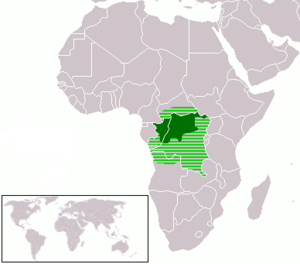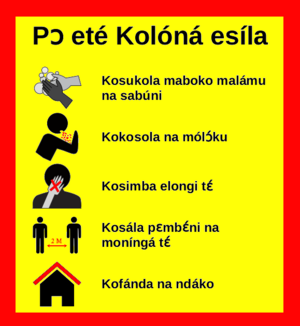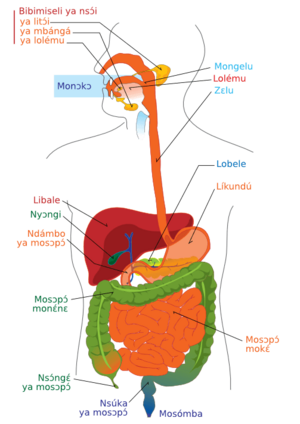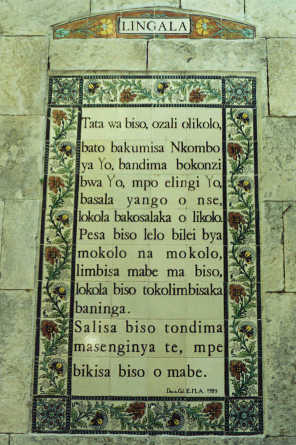Lingala facts for kids
Quick facts for kids Lingala |
||||
|---|---|---|---|---|
| Ngala Lingála |
||||
| Native to | Democratic Republic of the Congo, Republic of the Congo, Central African Republic, Angola and The Republic of South Sudan | |||
| Region | Congo River | |||
| Native speakers | Native speakers: 20 million (2020)e25 L2 speakers: 20 million speakers (2020) |
|||
| Language family |
Niger–Congo
|
|||
| Dialects |
Bangala
|
|||
| Writing system | African reference alphabet (Latin), Mandombe script | |||
| Official status | ||||
| Official language in |
|
|||
| Guthrie code | C30B | |||
| Linguasphere | 99-AUI-f | |||

Geographic distribution of Lingala speakers, showing regions of native speakers (dark green) and regions where Lingala is spoken by a minority. (light green)
|
||||
|
||||
Lingala (also called Ngala) is a language spoken in Central Africa. It's a type of Bantu language. You can hear it in the Democratic Republic of the Congo and the Republic of the Congo. It's also spoken in parts of Angola, the Central African Republic, and southern South Sudan.
Around 20 to 30 million people speak Lingala as their first language. Many more, about 35 million, speak it as a second language. This means a lot of people use Lingala every day!
Contents
History of Lingala
Before 1880, a language called Bobangi was very important for trade. It was used along the Congo river. When Europeans arrived in the 1880s, they started to learn Bobangi. But they didn't learn it perfectly. This led to a new, simpler version of the language. People called it "the trade language" or "the language of the river."
In 1884, this new language was used at a place called Bangala Station. It helped Europeans talk to local people. Because of this, the language soon got a new name: "Bangala."
Around 1901, some missionaries wanted to make the Bangala language "better." They thought it was too simple. So, they worked to make it more formal and complete. One important person in this effort was a Catholic missionary named Egide De Boeck.
Over time, Lingala became more and more important. This was especially true in big cities like Kinshasa and Brazzaville. It also became the common language for the armed forces. Plus, the popularity of soukous music helped Lingala spread even further.
What Lingala is Called
At first, the language created by Europeans and African troops had many names. People called it "the river language" or "the trade language." From 1884, it was known as "Bangala." This was because it was used a lot at Bangala Station.
After 1901, Catholic missionaries suggested a new name: "Lingala." It took many years for everyone to accept this name. However, in some parts of northeastern Congo, the language is still called Bangala. The name Lingala first appeared in writing around 1901-1902.
How Lingala Works and is Used
Lingala is a language that mixes parts of different languages. It mostly comes from the Bobangi language, which gave it most of its words and grammar rules. But Lingala also uses words from other languages. These include Kikongo, Ubangian languages, Swahili, French, Portuguese, and English.
The number of words borrowed from other languages can change. It depends on who is speaking and where they are from. Young people often use more borrowed words.
Here are some examples of words Lingala borrowed:
- From French:
* momí (from ma mie) means "girlfriend." * kelási means "class" or "school."
- From Spanish:
* chiclé means "chewing gum."
- From Portuguese:
* manteka means "butter." * mésa means "table." * sapátu means "shoes."
- From English:
* míliki means "milk." * súpu means "soup." * mamiwata means "mermaid." * búku means "book." * mótuka (from motor-car) means "car."
Different Kinds of Lingala
Lingala has different versions depending on the region or group of people speaking it. The main types are:
- Northwestern Lingala
- Kinshasa Lingala
- Brazzaville Lingala
Literary Lingala
This is a more formal and standard version of Lingala. It's used in schools, on news broadcasts, and in church services. It has specific rules for sounds and grammar. Many native speakers of everyday Lingala find this version hard to understand.
Spoken Lingala
This is the Lingala that people use in their daily lives. It's less formal than Literary Lingala. Many Lingala songs use Spoken Lingala. This version is often influenced by French. For example, French verbs might be changed to fit Lingala grammar. This happens more in Kinshasa, where French education is common.
There are also special ways of speaking Lingala:
- Lingala ya Bayankee (or Yanké) is a style used by young people in Kinshasa, like street vendors.
- Langila is a language game that musicians created. It's now used on social media.
Sounds of Lingala
Lingala is a tonal language. This means the meaning of a word can change depending on the pitch of your voice. For example, mutu (low tone) means "human being," but mutú (high tone) means "head."
There are two main tones: low and high. Sometimes, tones can go up or down within the same sound.
Grammar Basics
Like all Bantu languages, Lingala uses a system to group nouns. These groups are called noun classes. Nouns are put into classes based on the small parts (called prefixes) at the beginning of the word. These prefixes also show up on other words in the sentence that relate to the noun.
Here's a simple look at some noun classes:
| Class | Noun prefix | Example | Translation |
|---|---|---|---|
| 1 | mo- | mopési | giver |
| 2 | ba- | bapési | givers |
| 3 | mo- | mokíla | tail |
| 4 | mi- | mikíla | tails |
| 5 | li- | liloba | word |
| 6 | ma- | maloba | words |
| 7 | e- | elɔ́kɔ | thing |
| 8 | bi- | bilɔ́kɔ | things |
| 9 | m-/n- | ntaba | goat |
| 10 | m-/n- | ntaba | goats |
Each singular class (like 1, 3, 5, 7, 9) has a matching plural class (like 2, 4, 6, 8, 10). For example, a word in class 1 will have its plural in class 2.
Some words in class 9, especially for household items, use the ba- prefix (from class 2) for their plural. For example, lútu (spoon) becomes balútu (spoons).
The noun class prefixes don't just go on the noun. They also appear on other words in the sentence to show they are connected.
- molakisi molaí yangó abíkí (That tall teacher recovered)
- bato bakúmisa Nkómbó ya Yɔ́ (Let people praise Your name)
These classes often group similar things. For example, classes 1 and 2 usually have words for people. Classes 9 and 10 often have words for animals.
Writing Lingala
Lingala is more often spoken than written. There are different ways to write it down. Sometimes, the way it's written is influenced by French. For example, some writers might use "ou" for the "u" sound, like in French.
In 1976, a group of linguists (language experts) created a standard way to write Lingala. They decided to use special letters for certain vowel sounds. They also suggested using marks (accents) to show the tones. However, it can be hard to type these special characters and accents on a regular keyboard.
Because of this, many people writing Lingala online or in books don't use all the special characters or tone marks. They rely on the reader to understand the meaning from the context.
Lingala Alphabet

The Lingala alphabet has 35 letters and letter combinations (called digraphs). Each digraph has its own place in the alphabet. For example, "mb" comes after "m." The letters "r" and "h" are rare and mostly found in words borrowed from other languages.
Accents are used to show the tones:
- No accent means a low tone.
- An acute accent (like á) means a high tone.
- A circumflex accent (like â) means a falling tone.
- A caron accent (like ǎ) means a rising tone.
| Variants | Example | ||
|---|---|---|---|
| a | A | á â ǎ | nyama, matáta, sâmbóle, libwǎ |
| b | B | bísó | |
| c | C | ciluba | |
| d | D | madɛ́su | |
| e | E | é ê ě | komeka, mésa, kobênga |
| ɛ | Ɛ | ɛ́ ɛ̂ ɛ̌ | lɛlɔ́, lɛ́ki, tɛ̂ |
| f | F | lifúta | |
| g | G | kogánga | |
| gb | Gb | gbagba | |
| h | H | bohlu (bohrium) | |
| i | I | í î ǐ | wápi, zíko, tî, esǐ |
| k | K | kokoma | |
| l | L | kolála | |
| m | M | kokóma | |
| mb | Mb | kolámba, mbwá, mbɛlí | |
| mp | Mp | límpa | |
| n | N | líno | |
| nd | Nd | ndeko | |
| ng | Ng | ndéngé | |
| nk | Nk | nkámá | |
| ns | Ns | nsɔ́mi | |
| nt | Nt | ntaba | |
| ny | Ny | nyama | |
| nz | Nz | nzala | |
| o | o | ó ô ǒ | moto, sóngóló, sékô |
| ɔ | Ɔ | ɔ́ ɔ̂ ɔ̌ | sɔsɔ, yɔ́, sɔ̂lɔ, tɔ̌ |
| p | P | pɛnɛpɛnɛ | |
| r | R | malaríya | |
| s | S | kopésa | |
| t | T | tatá | |
| u | U | ú | butú, koúma |
| v | V | kovánda | |
| w | W | káwa | |
| y | Y | koyéba | |
| z | Z | kozala |
Sample Texts
| English | Lingala |
|---|---|
| I moved to Luanda in January this year due to a new job that I had applied for last year. I am happy that I got it and now I’m thinking of building a house in Mbanza Kongo next year so that my family can have a house. | Mbula oyo na bonguani na sanza ya yambo pona Luanda likolo ya mosala ya sika esika na mikomisaki kuna mbula eleki. Nazali na esengo pona ndenge na zui mosala oyo sikoyo nazali ko kanisa kotonga ndaku na Mbanza Kongo na mbula ezali ko ya pona ete libota bazala na ndaku. |
The Lord's Prayer (Catholic version)
-
- Tatá wa bísó, ozala o likoló,
- bato bakúmisa Nkómbó ya Yɔ́,
- bandima bokonzi bwa Yɔ́, mpo elingo Yɔ́,
- basálá yangó o nsé,
- lokóla bakosalaka o likoló
- Pésa bísó lɛlɔ́ biléi bya mokɔlɔ na mokɔlɔ,
- límbisa mabé ma bísó,
- lokóla bísó tokolimbisaka baníngá.
- Sálisa bísó tondima masɛ́nginyá tê,
- mpe bíkisa bísó o mabé.
-
- Na yɔ́ bokonzi,
- nguyá na nkembo,
- o bileko o binso sékô.
- Amen.
The Lord's Prayer (Protestant version used in Ubangi-Mongala region)
-
- Tatá na bísó na likoló,
- nkómbó na yɔ́ ezala mosanto,
- bokonzi na yɔ́ eya,
- mokano na yɔ́ esalama na nsé
- lokola na likoló.
- Pésa bísó kwanga ekokí lɛlɔ́.
- Límbisa bísó nyongo na bísó,
- pelamoko elimbisi bísó bango nyongo na bango.
- Kamba bísó kati na komekama tê,
- kasi bíkisa bísó na mabé.
-
- Mpo ete na yɔ́ ezalí bokonzi,
- na nguyá, na nkembo,
- lobiko na lobiko.
- Amen.
Sample text from Universal Declaration of Human Rights
- Bato nyonso na mbotama bazali nzomi pe bakokani na limemya pe makoki. Bazali na mayele pe base, geli kofanda na bondeko okati na bango.
- (Article 1 of Universal Declaration of Human Rights)
Mandombe Script
The Mandombe script is a special writing system. It is mainly used for the Kikongo language, but it can also be used to write Lingala. It is used in the church of Kimbangu.
See also
 In Spanish: Idioma lingala para niños
In Spanish: Idioma lingala para niños



